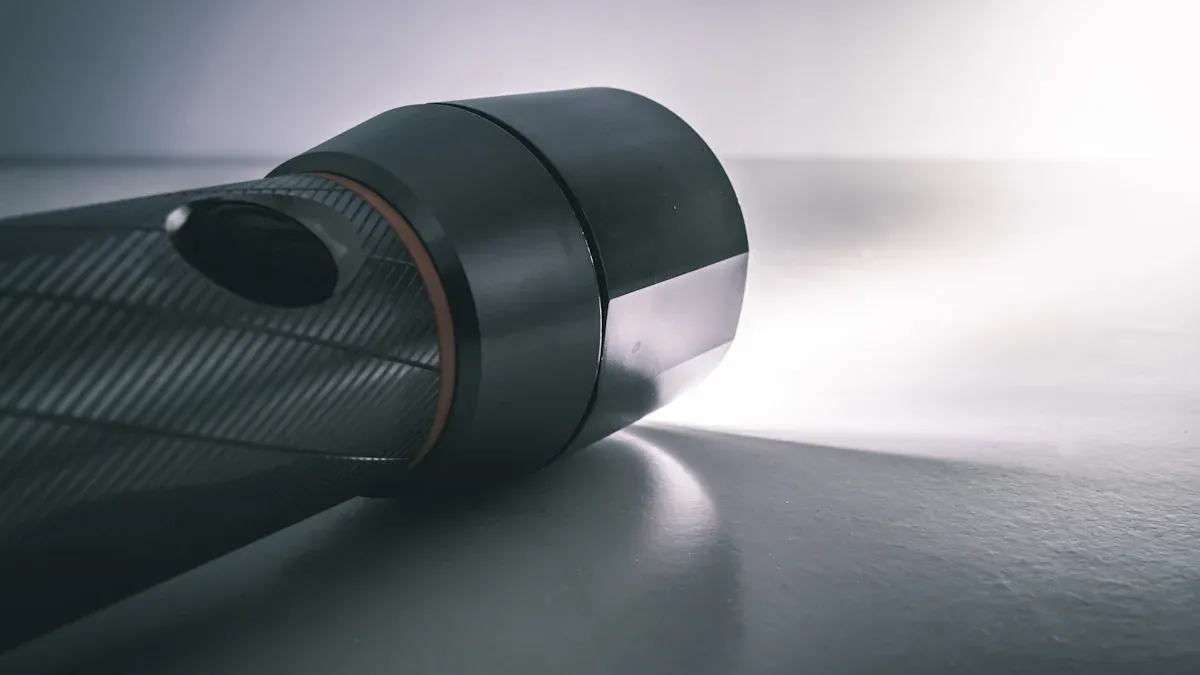
OEM partnerships play a crucial role in the LED flashlight industry, driving innovation and efficiency. The LED lighting OEM/ODM market, valued at USD 63.1 billion in 2024, is expected to grow to USD 112.5 billion by 2033, showcasing a CAGR of 6.7%. Companies like Ninghai County Yufei Plastic Electric Appliance Factory deliver customized solutions, offering products such as tactical flashlights and industrial hand lamps. These partnerships ensure businesses meet the evolving demands for reliable, long range flashlight options in global markets, including the growing China flashlight segment.
Key Takeaways
- OEM partnerships save money by letting companies focus on marketing. They can leave the production work to others.
- Working with OEMs helps create new ideas. This allows businesses to make special LED flashlight designs for customers.
- Strong, lasting relationships with OEM partners help both sides grow. They also adapt better to fast-changing markets.
Understanding OEM Partnerships in the LED Flashlight Industry
Defining OEM Partnerships
OEM (Original Equipment Manufacturer) partnerships involve collaborations where one company produces components or products that another company markets under its brand. In the LED flashlight industry, these partnerships enable businesses to outsource manufacturing while focusing on branding, marketing, and customer engagement. This approach allows companies to deliver high-quality products without the need for extensive in-house production facilities. For example, Ninghai County Yufei Plastic Electric Appliance Factory specializes in providing customized LED flashlight solutions, showcasing the value of OEM collaborations in creating tailored products for diverse market needs.
Relevance of OEM Partnerships to LED Flashlight Businesses
OEM partnerships hold significant importance for businesses in the LED flashlight sector. These collaborations offer several advantages:
- They provide custom functionality and white-labeled branding, which are essential for standing out in a competitive market.
- Strategic partnerships open doors to new verticals and markets, helping businesses expand their customer base.
- Companies can leverage their partners’ expertise and distribution networks, enhancing their market reach and competitiveness.
In a rapidly evolving industry, these partnerships allow businesses to adapt to changing consumer demands and technological advancements. By collaborating with reliable OEM partners, companies can focus on innovation and differentiation, ensuring their LED flashlight offerings remain relevant and appealing to customers.
Benefits of OEM Partnerships for LED Flashlight Companies

Cost Efficiency and Resource Optimization
OEM partnerships allow LED flashlight companies to achieve significant cost savings by optimizing resource allocation and streamlining operations. Collaborating with experienced OEMs eliminates the need for extensive in-house manufacturing facilities, reducing overhead costs. Companies can focus on their core competencies, such as branding and marketing, while their OEM partners handle production and supply chain management.
Several case studies highlight the financial benefits of OEM collaborations:
- Ngai Kwong International Ltd. (NKI) achieved a 30% reduction in costs by optimizing resource allocation and improving project management efficiency.
- A Fortune 250 global leader in motion and control technologies saved $554,040 through inventory management solutions, supplier reduction, and productivity enhancements.
These examples demonstrate how strategic partnerships with OEMs can lead to substantial cost savings, enabling businesses to allocate resources more effectively and remain competitive in the LED flashlight market.
Innovation and Differentiation in Product Design
Collaborating with OEM partners fosters innovation and enables LED flashlight companies to differentiate their products in a crowded marketplace. Joint Development Agreements (JDAs) between OEMs and their partners facilitate the co-creation of cutting-edge designs and features. By pooling expertise, companies can introduce unique products that cater to specific customer needs.
Other strategies, such as technology licensing and supplier integration, further enhance innovation. Licensing agreements allow companies to access advanced technologies without incurring high development costs. Close collaboration with suppliers ensures efficient production processes and the incorporation of innovative features. For instance, Ninghai County Yufei Plastic Electric Appliance Factory excels in delivering customized LED flashlight solutions, showcasing how OEM partnerships drive product differentiation and innovation.
Scalability and Market Adaptability
OEM partnerships provide the flexibility and scalability needed to adapt to changing market demands. These collaborations enable companies to scale production quickly, meet growing customer needs, and enter new markets. For example, partnerships have reduced the time-to-market for new LED technologies by 35%, allowing businesses to stay ahead of competitors.
Customization trends in the LED flashlight industry also benefit from OEM collaborations. By working closely with OEM partners, companies can develop tailored solutions that enhance customer satisfaction and brand loyalty. Additionally, joint R&D initiatives address unique engineering challenges, ensuring that LED flashlight designs remain scalable and adaptable to various applications.
In the rapidly evolving LED flashlight market, OEM partnerships empower businesses to innovate, scale, and adapt effectively, ensuring long-term success.
Challenges and Key Considerations in OEM Collaborations
Ensuring Quality and Compliance Standards
Maintaining quality and meeting compliance standards are critical in OEM collaborations. LED flashlight companies must ensure that their products adhere to global safety and quality benchmarks. Certifications such as CE, UL, and ISO 9001:2015 play a pivotal role in establishing trust and reliability.
| Certification | Description |
|---|---|
| CE | Compliance with European safety standards |
| UL | Underwriters Laboratories safety certification |
| ISO 9001:2015 | Quality management system certification |
These certifications demonstrate a commitment to safety, quality, and ethical practices. For instance:
- ISO 9001:2015 ensures consistent manufacturing processes.
- CE certification guarantees compliance with European safety regulations.
- amfori BSCI certification reflects adherence to ethical business practices.
Additionally, companies like Ninghai County Yufei Plastic Electric Appliance Factory conduct thorough inspections and provide accurate testing reports for each product, ensuring high standards are met.
Intellectual Property and Confidentiality Management
Protecting intellectual property (IP) is a significant challenge in OEM collaborations. Sharing sensitive designs and technologies with partners increases the risk of IP theft or infringement. Companies must implement robust confidentiality agreements and secure data-sharing protocols to mitigate these risks.
Building trust between partners is essential. Clear communication about IP ownership and usage rights fosters transparency and reduces potential conflicts. By prioritizing confidentiality, businesses can safeguard their innovations while benefiting from OEM partnerships.
Aligning Business Goals and Expectations
Aligning business goals is crucial for the success of OEM collaborations. Misaligned objectives can lead to inefficiencies and strained relationships. Industry reviews highlight the importance of aligning initiatives with key business goals, such as:
- Enhancing operational efficiency through cost reduction.
- Driving revenue growth by exploring new business models.
- Innovating products and processes to meet market demands.
- Improving customer satisfaction with tailored solutions.
Effective communication and regular strategic reviews help ensure that both parties remain aligned. Companies that prioritize shared objectives can achieve long-term success and mutual growth in the competitive LED flashlight market.
Strategies for Building Successful OEM Partnerships

Researching and Selecting Reliable OEM Partners
Selecting the right OEM partner is a critical step for businesses aiming to thrive in the LED flashlight industry. Companies must conduct thorough research to identify partners who align with their strategic goals and quality standards. Evaluating potential partners involves assessing their manufacturing capabilities, certifications, and track record in delivering high-quality products. For instance, certifications like ISO 9001:2015 and CE compliance indicate a commitment to quality and safety.
A comprehensive evaluation process helps prioritize initiatives that align with business objectives. The table below outlines common challenges and solutions in selecting reliable OEM partners:
| Challenge | Solution |
|---|---|
| Prioritization of Simpler Initiatives | Perform comprehensive evaluations to prioritize initiatives that align with strategic goals. |
| Resistance to Mindset Change | Establish reliable relationships through honest dialogue and offer training to foster collaboration. |
| Intensive Cross-Functional Involvement | Create dedicated cross-functional teams to oversee collaboration projects with clear roles. |
| Difficulty in Quantifying Value | Focus on strengthening supply chains while measuring collaboration value effectively. |
By addressing these challenges, businesses can build strong foundations for successful OEM partnerships, ensuring long-term growth and competitiveness.
Establishing Clear Communication and Collaboration
Effective communication forms the backbone of any successful OEM partnership. Open and transparent interaction fosters trust and ensures that both parties remain aligned on objectives. Regular meetings and the sharing of vital information help maintain clarity throughout the collaboration process. Understanding cultural nuances also plays a significant role, especially in global partnerships, as it influences teamwork and decision-making.
To overcome communication barriers, companies can adopt several strategies:
- Address language differences by employing multilingual team members or providing language training.
- Use collaboration frameworks that emphasize transparency and accountability.
- Leverage technology to streamline communication, such as project management tools and video conferencing platforms.
These practices enhance collaboration and minimize misunderstandings, enabling businesses to work seamlessly with their OEM partners. For example, companies in the LED flashlight sector can use these strategies to ensure that product specifications and timelines are clearly communicated, resulting in efficient production and delivery.
Fostering Long-Term Relationships for Mutual Growth
Building long-term relationships with OEM partners is essential for sustained success. Strong partnerships enable businesses to innovate, adapt to market changes, and achieve mutual growth. Companies should focus on nurturing trust and loyalty by maintaining consistent communication and delivering on commitments.
Joint development initiatives can further strengthen these relationships. By collaborating on research and development, businesses and their OEM partners can co-create innovative products that meet evolving customer demands. For instance, in the LED flashlight industry, joint R&D efforts can lead to the development of advanced features like enhanced battery life or improved durability.
Additionally, fostering long-term partnerships involves aligning business goals and sharing success. Companies can achieve this by:
- Conducting regular performance reviews to identify areas for improvement.
- Celebrating milestones and achievements together.
- Offering incentives for exceptional performance, such as bonuses or exclusive contracts.
These strategies create a win-win scenario, where both parties benefit from the partnership’s success. Businesses that prioritize long-term collaboration can maintain a competitive edge in the dynamic LED flashlight market.
OEM partnerships drive success in the LED flashlight industry by enabling cost efficiency, innovation, and scalability. Companies like Ninghai County Yufei Plastic Electric Appliance Factory showcase how strategic collaborations result in high-quality, customized products. Businesses should adopt a strategic mindset to address challenges and foster long-term growth through these partnerships.
FAQ
What is the difference between OEM and ODM in the LED flashlight industry?
OEM focuses on manufacturing products for branding by other companies. ODM designs and manufactures products that businesses can directly market.
How can businesses ensure quality in OEM partnerships?
Companies should verify certifications like ISO 9001:2015 and conduct regular inspections to maintain high standards and compliance.
Why are OEM partnerships important for scalability?
OEM collaborations enable businesses to scale production efficiently, meet growing demand, and adapt to market changes without investing heavily in infrastructure.
Post time: May-05-2025
